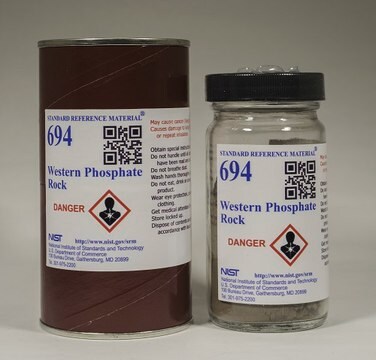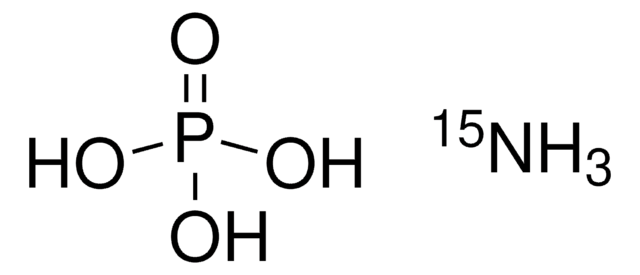Kluczowe dokumenty
NIST194A
Ammonium dihydrogen phosphate
NIST® SRM® 194a
Synonim(y):
Ammonium phosphate monobasic, mono-Ammonium phosphate, prim-Ammonium phosphate, Ammonium dihydrogenphosphate
About This Item
Polecane produkty
klasa czystości
certified reference material
Poziom jakości
opakowanie
pkg of 90 g
producent / nazwa handlowa
NIST®
mp
190 °C (dec.) (lit.)
Zastosowanie
agriculture
Format
neat
ciąg SMILES
N.OP(O)(O)=O
InChI
1S/H3N.H3O4P/c;1-5(2,3)4/h1H3;(H3,1,2,3,4)
Klucz InChI
LFVGISIMTYGQHF-UHFFFAOYSA-N
Szukasz podobnych produktów? Odwiedź Przewodnik dotyczący porównywania produktów
Powiązane kategorie
Opis ogólny
SRM 194A_cert
SRM 194A_SDS
Zastosowanie
- Improving fourth harmonic generation performance by elevating the operation temperature of ADP crystal: This study highlights the enhancement of fourth harmonic generation in ADP crystals by manipulating their operational temperature, demonstrating a crucial application in optical technologies (Liu et al., 2024).
- Growth and Temperature Properties of the Phase-Matching Angle of 23% Deuterated ADP Crystal: This research explores the phase-matching properties of deuterated ADP crystals, critical for improving the efficiency of nonlinear optical devices (Sun et al., 2024).
- Comparison of hydrogen vacancies in KDP and ADP crystals: This paper uses a combination of density functional theory and experimental approaches to study hydrogen vacancies in ADP crystals, providing insights into the structural properties that influence their optical performance (Sui et al., 2019).
- Structural, spectroscopic, optical, dielectric and mechanical study of pure and l-Proline doped ammonium dihydrogen phosphate single crystals: This comprehensive study addresses how doping ADP crystals with l-proline alters their physical properties, suggesting applications in both optical fields and material science (Hasmuddin et al., 2014).
Inne uwagi
Nitrogen (N), Phosphorus (P)
Reference/Informational value is provided for the following analytes.
Aluminum (Al), Fluorine (F), Neodymium (Nd), Sulfur (S), Antimony (Sb), Gadolinium (Gd), Nickel (Ni), Tantalum (Ta), Arsenic (As), Gallium (Ga), Niobium (Nb), Tellurium (Te), Barium (Ba), Germanium (Ge), Osmium (Os), Terbium (Tb), Beryllium (Be), Gold (Au), Palladium (Pd), Thallium (Th), Bismuth (Bi), Hafnium (Hf), Latinum (La), Thorium (Th), Boron (B), Holmium (Ho), Potassium (K), Thulium (Tm),Bromine (Br), Indium (In), Praseodymium (Pr), Tin (Sn), Cadmium (Cd), Iodine (I), Rhenium (Re), Titanium (Ti), Calcium (Ca), Iridium (Ir) Rhodium (Rh), Tungsten (W), Cerium (Ce), Iron (Fe) Rubidium (Rb), Uranium (U), Cesium (Ce), Lanthanum (La), Ruthenium (Ru), Vanadium (V), Chlorine (Cl), Lead (Pb), Samarium (Sm), Ytterbium (Yb), Chromium (Cr), Lithium (Li), Scandium (Sc), Yttrium (Yt), Cobalt (Co), Lutetium (Lu), Selenium (Se), Zinc (Zn), Copper (Cu), Magnesium (Mg), Silicon (Si), Zirconium (Zr), Dysprosium (Dy), Manganese (Mn), Silver (Ag), Erbium (Er) Mercury (Hg), Sodium (Na), Europium (Eu), Molybdenum (Mo), Strontium (Sr)
See certificate for values and more details at nist.gov/SRM.
Informacje prawne
produkt powiązany
Kod klasy składowania
13 - Non Combustible Solids
Klasa zagrożenia wodnego (WGK)
WGK 1
Temperatura zapłonu (°F)
Not applicable
Temperatura zapłonu (°C)
Not applicable
Wykazy regulacyjne
Wykazy regulacyjne dotyczą głównie produktów chemicznych. Można w nich podawać ograniczoną liczbę informacji na temat produktów niechemicznych. Brak wpisu oznacza, że żaden ze składników nie znajduje się w wykazie. Użytkownik odpowiada za zagwarantowanie bezpiecznego i zgodnego z prawem stosowania produktu.
EU REACH Annex XVII (Restriction List)
Wybierz jedną z najnowszych wersji:
Certyfikaty analizy (CoA)
It looks like we've run into a problem, but you can still download Certificates of Analysis from our Dokumenty section.
Proszę o kontakt, jeśli potrzebna jest pomoc Obsługa Klienta
Masz już ten produkt?
Dokumenty związane z niedawno zakupionymi produktami zostały zamieszczone w Bibliotece dokumentów.
Klienci oglądali również te produkty
Nasz zespół naukowców ma doświadczenie we wszystkich obszarach badań, w tym w naukach przyrodniczych, materiałoznawstwie, syntezie chemicznej, chromatografii, analityce i wielu innych dziedzinach.
Skontaktuj się z zespołem ds. pomocy technicznej






